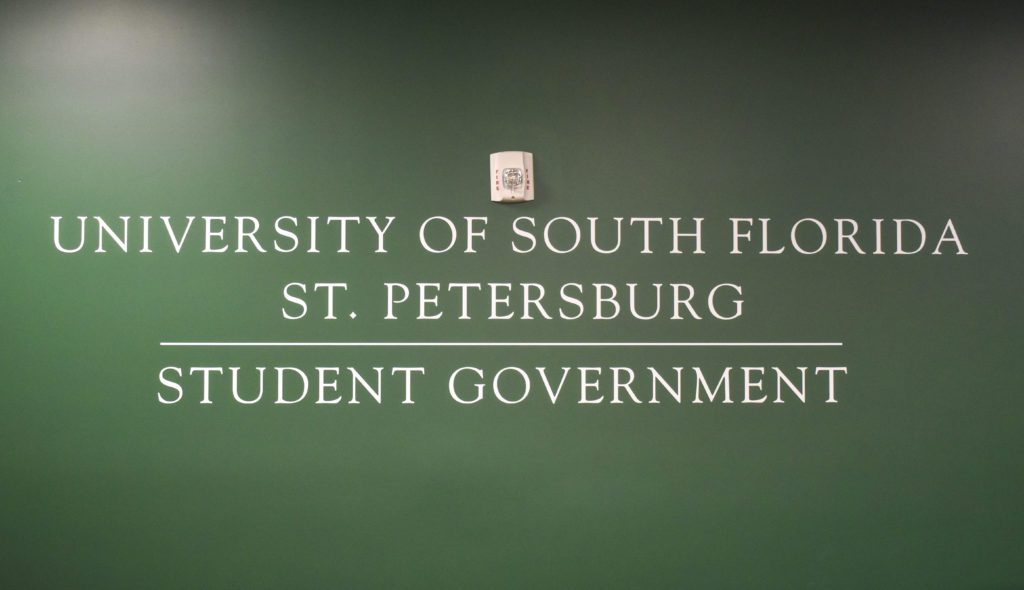The new constitution will be voted on October 14.

Crow’s Nest file photo
By Dylan Hart
For years, the student senate in St. Petersburg has decided how to spread the revenue generated by students’ Activities and Services fees among several campus organizations.
But under a proposed reorganization of student government on USF’s three campuses, that job would pass to a senate based in Tampa and dominated by Tampa-based senators.
That’s just one of the changes in the draft of SG’s new constitution, which outlines how the organization would function once the USF system is consolidated in July.
The proposed constitution is headed to a vote at each campus’ SG general assembly meeting this week, followed by student referendums on all three campuses.
It would reorganize SG to center legislative power at USF Tampa and leave smaller, local affairs to “campus councils.”
In the constitution, campus councils — which would replace campus-specific senates — only have the power to “recommend allocations of the Activity and Service Fee to the Senate Fiscal Committee.”
Meanwhile, the senate, which would be housed at USF Tampa, would have the “authority to approve and allocate all Activity and Service fee appropriations by a majority vote.”
On all three campuses, SG now allocates A&S fee revenue to numerous campus organizations. In St. Petersburg, this includes The Crow’s Nest, the Student Green Energy Fund, the Office of Multicultural Affairs and the Harborside Activities Board, as well as SG, which shared $3.1 million in 2019-2020.
If the final decision on funding goes to the senate in Tampa as proposed, the three campus councils would only be able to recommend changes. A centralized budget could leave campus-specific organizations on the cutting room floor.
The structure
Trevor Martindale, the chief legal officer for St. Petersburg SG, likened the new structure to a “federal and state” system, where each campus is a “state” and the new senate would exist as a federal body.
Like the current system, the university SG would have a legislative branch, a judicial branch and an executive branch. But localized versions of each branch would exist on each campus.
The most impactful changes would come to the legislative branch, where laws are drafted and enacted.
Each campus would host a campus council, akin to today’s individual campus senates. But the overarching university senate would have 60 seats. Five would be guaranteed to each campus, and the other 45 seats would be apportioned “according to the percentages of the total number of students enrolled at each Campus.”
The particular breakdown of how many seats would be afforded to each campus would be decided when SG votes on statutes later this month.
The wording does leave the door open for campus growth or shrinkage, which could change the number of seats allocated to each campus.
Students would vote for senators from across all three campuses. This means students at USF St. Petersburg would have to pick among unfamiliar faces to represent them.
“A good senator would campaign across all three campuses,” said USF St. Petersburg Senate President Katherine Fishman.
Fishman said that the proposed constitution does establish a strong divide between local and university-wide affairs in the legislative branch.
The constitution says that “all campus legislative powers of the Student Body shall be vested in each USF Campus Council,” but without statutes, the constitution affords no actual power to the council beyond confirming campus-specific SG staff.
“The councils have the power to change their local rules and policies, appoint people to their local government, and make recommendations to the Senate as to the allocation of A&S fees,” Fishman said in an email.
The council committees would be chaired by senators of the university-wide senate, while other council members would be elected separately.
The judicial system
A big concern among St. Petersburg SG members at an Oct. 7 meeting was the imbalance in the proposed SG Supreme Court structure.
Under the new constitution, USF Tampa would host the Supreme Court. Five of the justices would come from the Tampa campus, while St. Petersburg and Sarasota-Manatee would get two each, giving Tampa’s justices a permanent majority.
One of the nine justices would be the chief justice, a “current Justice or Judge” appointed by the student body president.
The judicial branch would have “the power to declare any act of Student Government unconstitutional,” and would oversee all cases of impeachment ordered by the senate. More specific duties, like court rules, would be decided later, when SG develops statutes and judicial rules of procedures.
Localized “circuit courts” would host five judges, including a chief judge, all selected by each campus’ governor. The powers of the circuit courts are not defined in the constitution, but the current campus judicial branch covers constitutional disputes in the legislative branch and parking ticket appeals.
The executive branch
All students would vote for one student body president and vice president ticket. Like the current system, the student body president would represent students before organizations like the USF Board of Trustees and the Florida Student Association.
The student body president would also sign or veto legislation passed by the senate, nominate certain members of the judicial system and oversee the USF executive branch.
Under the student body president, each campus would have a governor and lieutenant governor, who would perform similar duties at the local level. In the constitution, governors are only given the power to appoint specific positions within their cabinet and judicial branch.
The constitution does not specify if students could vote for governors and lieutenant governors from other campuses.
Uncertainty still looms
A significant piece of the puzzle — the statutes — is still missing. SG plans to develop statutes in the next few weeks, which would determine more specific rules for how SG’s branches will function and how students can interact with SG.
Although imbalances exist at the university’s top level, Fishman said she had confidence in the democratic process to solve any potential bias.
“If a Senator/Senators (from any campus) were to sway the budgeting process or legislative process in an unfair or biased way, they could easily be voted out of office,” she said in an email.
However, USF St. Petersburg has a historically low voter turnout. In the spring, only 574 students voted in student body general elections, which was about 13 percent of the student body.
At last week’s general assembly meeting, the USF St. Petersburg senate also created an ad hoc committee on consolidation to help answer students’ questions about the new structure.
“Just simple, unofficial meetings, I don’t think would do,” Fishman said. “So I thought it was necessary to create this ad hoc committee in an official capacity.”
Alongside this, USF St. Petersburg Student Body President Jadzia “Jazzy” Duarte said that all three campuses plan to launch individual “vote yes” campaigns next week to push students to vote in favor of SG’s draft.
If “half plus some” of the students vote no on the constitution, Duarte said, the draft will be out of SG’s hands. It would go to university administration for a final decision.



